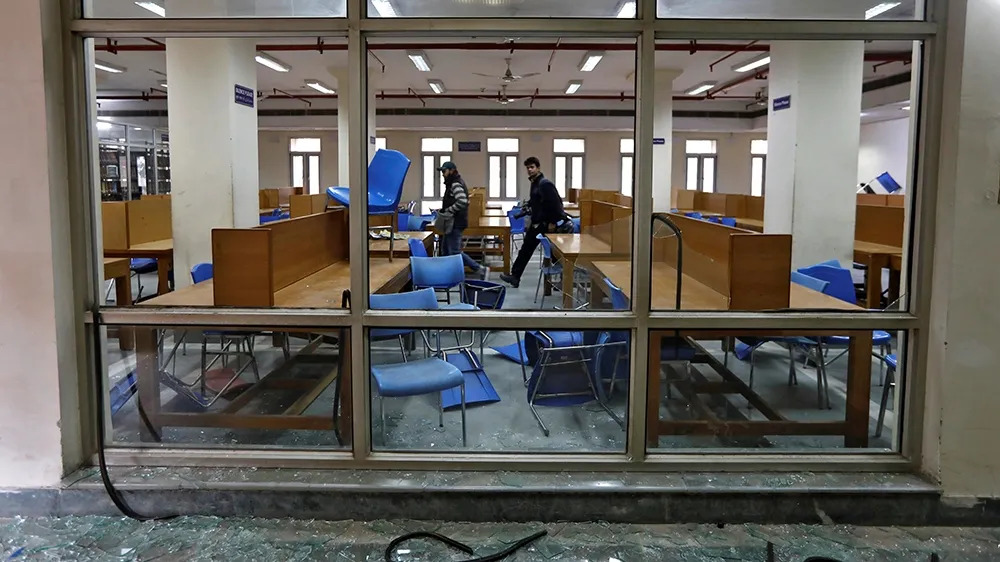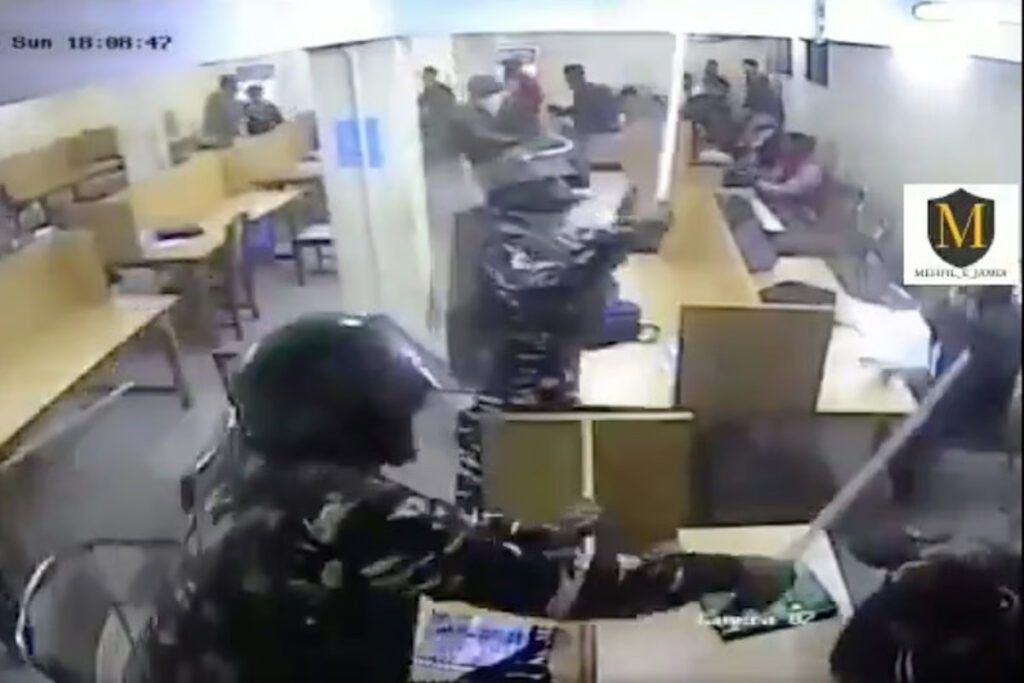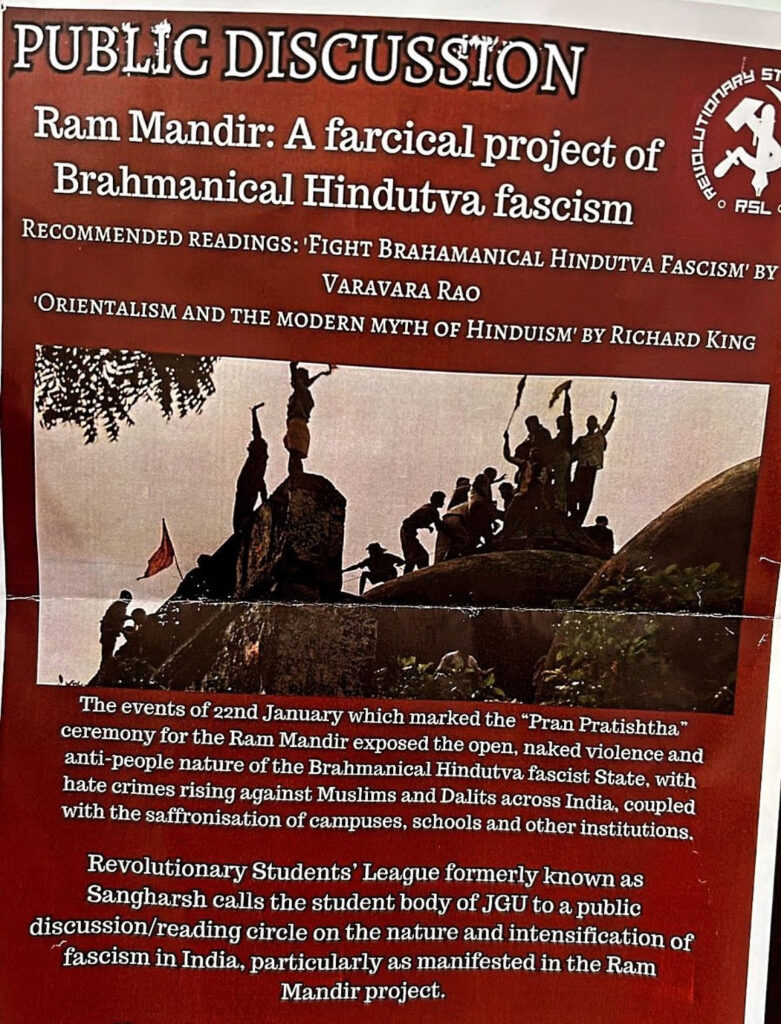Downloaded from New York Times. Student protests at the Jawaharlal Nehru University campus, New Delhi in 2020.
Hinduizing the University: Academic (Un)Freedom on the Indian Campus
Anonymous Student

Downloaded from Al Jazeera. Damaged parts of Jamia Millia Islamia’s campus in New Delhi after a raid by the Delhi Police following student-led protests against the CAA/NRC bills.
At the core of autocratizing democracies is a systematic targeting of its campuses. An erosion of the university’s liberal animus is essential to the culling of any progressive thought. The Indian campus is no stranger to political strife since the rise of the Bharatiya Janata Party (BJP) in 2014. Its leader and India’s now three-time Prime Minister, Narendra Modi, has brought to the fore an ideology of hypernationalism. Hindutva or Hindu nationalism is an ideology espoused by the BJP and its parent-paramilitary organization, the Rashtriya Swayamsewak Sangh (RSS). It imagines India as a Hindu supremacist and ethnonationalist nation (South Asia Scholar Activist Collective, n.d.).
The Indian campus space has been a site of political genesis for national movements and a laboratory for its greatest and even most contentious leaders. Its protection largely stood the test of time since its Independence in 1947. However, the ascendance of the BJP since the 2014 national elections, its ideological coda of Hindu nationalism, and its mobilizational strength outside the electoral sphere have restricted and assaulted the freedom of thought on the Indian campus. The Scholars at Risk Network found that between 2023 and 2024, India’s academic freedom was at an all-time low since the “mid-1940s” (Scholars at Risk Network 2024). India ranks 161 out of 179 countries on the academic freedom index, highlighting the deteriorating state of the world’s largest democracy (Pradhan 2024).
Late Manmohan Singh, former Prime Minister and leader of the United Progressive Alliance (UPA) from the Indian National Congress (INC) party, visited the campus of Jawaharlal Nehru University (JNU) in 2005. He was greeted by a body of students waving black flags. Despite the university taking action against the students involved, Manmohan Singh intervened directly and asked the administration to respect the students’ right to express their opinions (The Tribune 2020). JNU’s image, one that I remember newspapers recurringly projecting throughout my life in India, is of a rebellious student body dedicated to leftist politics. With the strong presence of Communist and leftist student groups such as the All India Students Association (AISA) as well as groups representing the historically marginalised castes and tribes of India like the All India Backward Students Forum (AIBSF), the university’s ‘anti establishment’ sentiments have been central to concretising its fortitude in protecting minority rights, freedom of expression and on-campus intersectional representation.
The CAA/NRC experience at Jamia Millia Islamia University
“Inside (the library) they broke everything, beat students without any care and regard for standard operating procedure. They beat students on their heads and mostly the upper part of the body,” an anonymous student at JMI (Al Jazeera 2020).
In 2019, the BJP government pushed through a legislation in both houses of India’s parliament, amending the citizenship law in India. The Citizenship Amendment Act (2019) (CAA) fast-tracked refugee applications for non-Muslims from India’s neighbouring countries while reserving the category of “illegal immigrants” for Muslims (USCIRF 2020). The law engendered the Hindu nationalist belief of ghar wapasi (homecoming). A manifestation of the Hindutva imaginary that South Asian Hindus oppressed in the Muslim majority neighborhood of India, must be saved and brought back home (Grane 2024). Protests erupted in all metropolitan areas in India. One of the epicentres became the Jamia Milia Islamia University (JMI) in New Delhi. The predominantly Muslim university that also offers scholarships and affirmative action programs for students from India’s largest minority community was subjected to a brutal police crackdown. On December 15, 2019, the Delhi Police stormed the campus. Amidst baton charges and evidence of 25 CCTV cameras being deliberately destroyed, students reported being brutally injured and repeatedly stressed that the Police aimed for the upper bodies of students (The Wire Staff 2020). The main video that went viral shows students barricading the doors of a library as the Police break them down and start attacking all students in sight, leaving hundreds injured (The Wire Staff 2020). Tear gas and smoke bombs were fired indoors on campus premises. Multiple students reported being attacked as Islamophobic slurs were hurled at them by police officers. Videos show no attempts by police officers to arrest the students (Kaushal 2020).

Downloaded from The News Minute. CCTV footage of Delhi Police’s attack on Jamia Millia Islamia Campus in 2019
The aftermath of the CAA protests saw an administration concertedly targeting student groups. Delhi Police, which comes under the federal jurisdiction of India’s Home Ministry, is run by top Modi aide Amit Shah and has been pulled up by several tranches of India’s court systems for its apparent incompetence. Chargesheets filed by the police have failed to corroborate First Information Reports (FIR) filed by victims and civil society groups established fact-finding patterns of brazen and unlawful use of excessive force by the Delhi Police. Students were arrested and charged under the draconian Unlawful Activities Prevention (Amended) Act (UAPA) (Sharma 2023). Some of them remain in prison. Of these, the cases of Umar Khalid, a PhD student at JNU (USCIRF, n.d.); Shafi-ur Rehman, the President of the Alumni Association at JMI (USCIRF, n.d.); and Sharjeel Imam, another PhD student (USCIRF, n.d.), have become testaments to the campaign of denial surrounding justice in the aftermath of the anti-CAA protests in New Delhi. They languish in prison under a barrage of fabricated cases without having seen a fair trial.
Denial has also taken the form of oppressing commemoration. The JMI admin has censured successive anniversaries of the brutal police crackdown on campus by sealing the campus premises. Often using reasons such as “maintenance” (PTI 2024). In October 2024, the President of India appointed Professor Mazhar Asif as the new Vice Chancellor of JMI. Student bodies were quick to point out his affiliations with the Hindu right-wing. Asif had been a part of the Akhil Bhartiya Vidyarthi Parishad, the student wing of the RSS, a paramilitary and extrapolitical group that serves as the parent organization of the Hindu right-wing in India. Asif has previously expressed views in support of the CAA and has also previously been a part of the Muslim Rashtriya Manch, an RSS-affiliated group (Faris and Jain 2024). His appointment seems like a deliberate attempt to stifle the politics on campus or appoint a government-friendly VC to reposture campus administration and recalibrate priorities and repress political studentry. The VC’s office is also seeking to affect the makeup of admissions. The university offers 50% reservation for PhD slots to Muslim students. Using a change in regulation language, the administration has permitted itself to overlook this reservation and grant higher than 50% admissions to non-Muslim candidates (Faris and Ramanarayanan 2025).
The government of India has been able to utilize its provisions by appointing the VC of a university to interfere directly with the campus’s political dynamic. It is important to clarify here that the appointment of the President of India, who chooses the VC of JMI, as with some other federal universities, is nominal. Their role customarily falls in line with the ruling party’s politics and, in the recent past, has not offered challenging opinions.
Saffronizing Private Universities: O.P. Jindal Global University and Ashoka University
“You were found to have been putting up posters and engaging in conversation that involved extremely derogatory and provocative words…aimed at affecting the integrity and tranquility of the university space,” – university statement to students (The Wire Staff 2024).
O.P. Jindal and Ashoka University are both situated in remote parts of North India. These private liberal arts universities have sought to invigorate the social sciences in India by bringing large sums of funding from private and international donors. However, their high fee structures largely limit access to students from privileged backgrounds. Their existence in the countryside causes an architectural aberration – students from economically privileged backgrounds are atomized in the middle of rural communities and economically poorer surroundings. This restricts campus politics within its physical walls. Students shared content and testimonies recounting the growth of Hindutva on the campus of O.P. Jindal Global University. Student-led vigilantism through groups, as well as readily available mobilizations available through social media platforms like ‘X’ have offered right-wing nationalists a frenzied vehicle of intimidation against academics.
In 2024, Indian PM Narendra Modi inaugurated the Ram Temple at Ayodhya. The inauguration came after decades of controversy over an unlawful demolition of a historic mosque by a right-wing mob in 1992 (Pandey and Limaye 2024). The national mobilization that led to the demolition of the mosque is consecrated in the memory of the BJP and the RSS as a movement. Opposition toward the inauguration of the temple in 2024 was led by the intelligentsia as well as student-led groups, predominantly from the left (Krishnan 2024). On the O.P. Jindal campus, the Revolutionary Students League (RSL) organized a program titled “Ram Mandir: a Farcical Project of Brahminical Hindutva Fascism”. The event was attended by over 20 members of a right-wing student group called Abhinav Bharat. Members of this student group interrupted the session with chants of “Jai Shri Ram” (Hail Lord Ram), a slogan co-opted by the Hindu right-wing as a rally cry in the public and, in this case, the university-scape (Howale 2024). Despite Abhinav Bharat’s interruption of the programme, student organizers from RSL were suspended and held accountable for their “derogatory” and “provocative language”. Pro-Hindutva students posted doctored and heavily edited portions of recordings from the programme on social media platforms, which led to a campaign of harassment against the two students forcefully evicted from the campus.
This medium of moral policing and ideological vigilantism is given life by a nocturnal network of Hindutva pages across social media platforms that command immense followings. The fear of impetuous narrative-building against the university’s reputation drives administrators’ decisions to take punitive action against students–the low-hanging fruit. This network, however, does not spare a campus’s academics. Another incident from the same university in September 2023 brought the classroom under the direct scrutiny of prevailing political narratives (Aafaq 2024). A professor’s class practices were questioned by a section of her students, who took to social media to display their disaffection with their professor using a dating app as a means of live experimentation. Pro-Hindutva students in her class were quick to point out her earlier opposition to students chanting “Jai Shree Ram”. She was soon targeted online for spreading hatred against Hindus, and the university’s chancellor was visited by the state’s women’s rights commission as a means of public reprimand for her actions in the classroom.

Downloaded from Newslaundry. A copy of the poster circulated at the O.P. Jindal campus
At Ashoka University, the most telling sign of Hindutva on campus was a professor’s research into alleged electoral manipulations targeting the Muslim community in the 2019 national elections (Das, n.d.). The paper, which Professor Sabyasachi Das himself shared online, received backlash from the BJP’s supporters, and the university distanced itself from his findings, calling its review process “incomplete” (Sarkar 2023). Officials from the Intelligence Bureau, India’s domestic intelligence agency, also visited the campus to speak to Das’s colleagues (Varadrajan 2023). Professor Das was forced to resign despite vocal backing from the faculty and students. This invited scrutiny into Ashoka’s other projects. Less than a month later, the university’s award-winning Trivedi Centre for Political Data (TCPD) was “hollowed out” and shut down. Its founder, Gilles Verniers, was forced to resign, and a months-long drain on their resources imposed by the university meant they shut shop (Mittal and Sidharth 2023). Verniers appears to have been forced out as a result of failing to achieve requirements for a tenure track, which he says he did (with the documents to prove it). It may very well be assumed that the university decided to reformulate its research imperatives in light of the scrutiny its work was attracting.
Conclusion
The Jamia example provides an institutional blueprint for the current government’s viewing of Muslims as a problem. Their political collectivization appears as an issue that must be pacified using all institutional levers available. Thus, a loyalist must be appointed to both, report on, and suppress the campus politics in a multidirectional undoing of an affirmative action institution for India’s largest minority. The Indian university campus is a rare exception for campus politics because of the presence of student parapolitical outfits that have direct institutional ties to parties in power. This mandates not just the need to maintain power amongst student bodies as a means of control but also acting as moral and political ombudsmen towards their peers’ actions. Where enough social capital is lacking for these groups to affect their peers, they use the social media troll-factories that are quick to propel single instances to national news.
Through these examples, one can tell that anecdotal cases are purposely magnified to achieve the “punishment puzzle” across classrooms in the country; this also sets a precedent for universities looking for ways to fall in line. Provisions of means to acquiesce thus become the primary format for universities to remain compliant. No consistent lawmaking is requested of them in so far as ideological fear-mongering is concerned. Because that sustains the limitlessness of the punishment game.
References
Aafaq, Zafar. 2024. “From IIT Bombay to Jindal university, student videos used to target faculty on Israel-Palestine war.” The Scroll, November Sunday, 2024. https://scroll.in/article/1059193/from-jindal-university-to-iit-bombay-student-videos-used-to-target-faculty-on-israel-palestine-war.
Al Jazeera. 2020. “India: Footage appears to show police attack on Jamia students.” Al Jazeera, February 16, 2020. https://www.aljazeera.com/news/2020/2/16/india-footage-appears-to-show-police-attack-on-jamia-students.
Das, Sabyasachi. n.d. “Democratic Backsliding in the World’s Largest Democracy.” Social Sciences Research Network. https://dx.doi.org/10.2139/ssrn.4512936.
Faris, Sahid, and Nikita Jain. 2024. “Students say new Jamia Millia Islamia VC Mazhar Asif has ties to RSS, raising concerns.” Maktoob Media, October 25, 2024. https://maktoobmedia.com/india/students-say-new-jamia-millia-islamia-vc-mazhar-asif-has-ties-to-rss-raising-concerns/.
Faris, Sahid, and Nikita Ramanarayanan. 2025. “Sabotaging Muslim reservation?: Quota rules flouted in Jamia Millia PhD admissions.” Maktoob Media, February 27, 2025. https://maktoobmedia.com/india/sabotaging-muslim-reservation-quota-rules-flouted-in-jamia-millia-phd-admissions/.
Grane, Kevin. 2024. “Dangerous Ramifications of Recent Ghar Wapsi Efforts.” Religion in Transition 7 (April).
Howale, Atul. 2024. “Students, Alumni of Jindal University Protest Suspension of Organisers of Ram Mandir Discussion.” The Wire, February Wednesday, 2024. https://thewire.in/education/students-alumni-of-jindal-university-protest-suspension-of-organisers-of-ram-mandir-discussion.
Kaushal, Ravi. 2020. “Jamia Students Recount Night of Terror as CCTV Footage Demolishes Police Claims.” NewsClick, February Monday, 2020. https://www.newsclick.in/Jamia-Millia-Islamia-Delhi-Police-Violence-Brutality.
Krishnan, Murali. 2024. “India: Ram Temple inauguration stokes political controversy – DW – 01/22/2024.” DW, January 22, 2024. https://www.dw.com/en/india-ram-temple-inauguration-stokes-political-controversy/a-68030692.
Mittal, Devansh, and Jyotsna Sidharth. 2023. “How Ashoka University’s Award-Winning Trivedi Centre for Political Data Was Hollowed Out.” The Wire, September Tuesday, 2023. https://thewire.in/education/how-ashoka-universitys-award-winning-tcpd-was-hollowed-out.
Pandey, Geeta, and Yogita Limaye. 2024. “Ayodhya Ram Mandir: India PM Modi inaugurates Hindu temple on razed Babri mosque site.” BBC, January 22, 2024. https://www.bbc.com/news/world-asia-india-68003095.
Pradhan, Saloni. 2024. “India’s Academic Freedom is at Stake.” the Loop: ECPR. https://theloop.ecpr.eu/indias-academic-freedom-is-at-stake/.
PTI. 2024. “Jamia shuts classes, library on anti-CAA protest anniversary; Student outfit AISA hits out.” Indian Express, December Sunday, 2024. https://indianexpress.com/article/cities/delhi/jamia-shuts-classes-library-anti-caa-protest-anniversary-9726436/.
Sarkar, Sonia. 2023. “Row at India’s premier private university sparks debate on academic freedom.” Al Jazeera, August Monday, 2023. https://www.aljazeera.com/news/2023/8/28/row-at-indias-premier-private-university-sparks-debate-on-academic-freedom.
Scholars at Risk Network. 2024. “Free to Think Report of the Scholars at Risk Academic Freedom Monitoring Project.” Scholars at Risk. https://www.scholarsatrisk.org/resources/free-to-think-2024/#section1.
Sharma, Betwa. 2023. “3 Years Since Delhi Police Accused Jamia Students Of Rioting, Chargesheets Reveal They May Have No Case.” Article 14, February Friday, 2023. https://article-14.com/post/3-years-since-delhi-police-accused-jamia-students-of-rioting-chargesheets-reveal-they-may-have-no-case-63dc69ca28c56.
South Asia Scholar Activist Collective. n.d. “What is Hindutva?” Hindutva Harassment Field Manual. Accessed March 10, 2025. https://www.hindutvaharassmentfieldmanual.org/defininghindutva.
The Wire Staff. 2020. “Police Action Damaged 25 CCTV Cameras on Campus, Jamia Tells MHRD.” The Wire, February Wednesday, 2020. https://thewire.in/rights/police-action-damaged-25-cctv-cameras-on-campus-jamia-tells-mhrd.
The Wire Staff. 2024. “OP Jindal Global University Suspends Two Students Over Ram Mandir Discussion.” The Wire, February Friday, 2024. https://thewire.in/rights/op-jindal-global-university-suspends-two-students-over-ram-mandir-discussion.
The Tribune. 2020. “When then PM Manmohan Singh stepped in to get JNU protesters off the hook.” The Tribune, January Monday, 2020. https://www.tribuneindia.com/news/nation/when-then-pm-manmohan-singh-stepped-in-to-get-jnu-protesters-off-the-hook-25633/.
United States Commission on International Religious Freedom. 2020. “Legislation Factsheet: India.” USCIRF. https://www.uscirf.gov/sites/default/files/2020%20Legislation%20Factsheet%20-%20India_0_0.pdf.
USCIRF. n.d. “Sharjeel Imam | USCIRF.” US Commission on International Religious Freedom. Accessed March 10, 2025. https://www.uscirf.gov/religious-prisoners-conscience/forb-victims-database/sharjeel-imam.
USCIRF. n.d. “Shifa ur-Rehman | USCIRF.” US Commission on International Religious Freedom. Accessed March 10, 2025. https://www.uscirf.gov/religious-prisoners-conscience/forb-victims-database/shifa-ur-rehman.
USCIRF. n.d. “Umar Khalid | USCIRF.” US Commission on International Religious Freedom. Accessed March 10, 2025. https://www.uscirf.gov/religious-prisoners-conscience/forb-victims-database/umar-khalid.
Varadrajan, Siddharth. 2023. “Intelligence Bureau At Ashoka University, Wants To Probe ‘Democratic Backsliding’ Paper ( The Wire ).” Hindutva Watch, August Tuesday, 2023. https://www.hindutvawatch.org/intelligence-bureau-at-ashoka-university-wants-to-probe-democratic-backsliding-paper-the-wire/.
